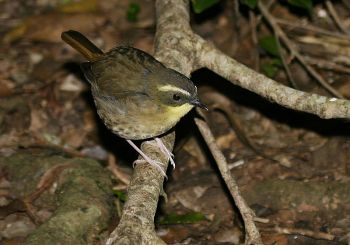- Neosericornis citreogularis
Sericornis citreogularis
Identification
12–15 cm (4¾-6 in)
Males:
- Black facial mask and forehead
- White and yellow supercilium
- Bright yellow throat
- Dark olive brown crown and back
- White belly
- Olive flanks
- Dark greyish brown wings with yellowy outer edges
- Cream to pinkish grey legs
- Black bill
Females: brown face mask and forehead
Young birds are duller than adults, with fawn underparts.
Distribution
East coast of Australia: found in New South Wales, Queensland and Victoria
Taxonomy
Subspecies
There are 3 subspecies[1]:
- N. c. cairnsi:
- North-eastern Queensland (Cooktown to Paluma Range)
- N. c. intermedius:
- Eastern Australia (south-eastern Queensland to Clarence River, New South Wales)
- N. c. citreogularis:
- Eastern New South Wales (Clarence River to Mount Dromedary)
Habitat
Dark understorey of coastal rainforests and wet, timbered gullies with dense vegetation.
Behaviour

Photo © by Delia Todd
Lamington NP, Queensland, Australia, 16 October 2019
Diet
Their diet consists mostly of insects, worms and spiders, with the inclusion of seeds, fungus and fruit.
Breeding
They build a long, bulky domed nest with a hooded side entrance, from roots, vine tendrils, leaf skeletons, moss and twigs, and lined with feathers. The clutch consists of 2-3 brownish purple to pale brownish white eggs with darker spots or blotches.
References
- Clements, J. F., T. S. Schulenberg, M. J. Iliff, T. A. Fredericks, J. A. Gerbracht, D. Lepage, S. M. Billerman, B. L. Sullivan, and C. L. Wood. 2022. The eBird/Clements checklist of Birds of the World: v2022. Downloaded from https://www.birds.cornell.edu/clementschecklist/download/
- Avibase
- Handbook of the Birds of the World Alive (retrieved November 2016)
- Birds in Backyards
Recommended Citation
- BirdForum Opus contributors. (2024) Yellow-throated Scrubwren. In: BirdForum, the forum for wild birds and birding. Retrieved 24 April 2024 from https://www.birdforum.net/opus/Yellow-throated_Scrubwren
External Links
GSearch checked for 2020 platform.





